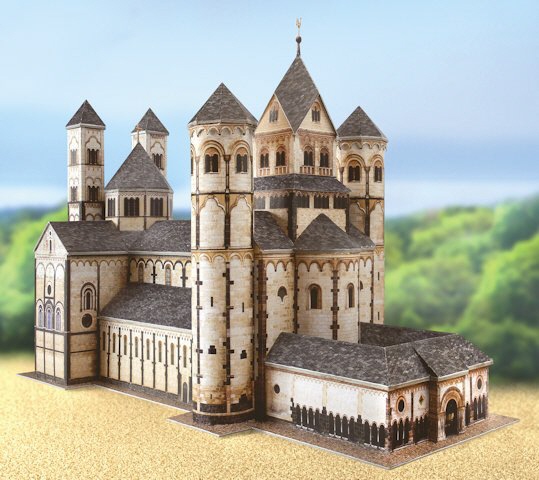Abteikirche Maria Laach

German title: Abteikirche Maria Laach
Scale: 1:300
Length: 28 cm
Width: 12 cm
Height: 16 cm
Degree of difficulty: 1 (easy)
Number of sheets: 3.5
The monastery’s history: The name Maria Laach is derived from Abbatia S. Mariae ad Lacum (abbey of Holy Mary by the lake, simplified as “Laach”) as the monastery used to be called in Latin. Maria Laach was founded in 1093 by count palatine Heinrich II of Luxemburg-Gleiberg. He donated his possessions for the formation of Benedictine order. The count died only two years later, his work was continued by his wife, countess palatine Adelheid. Heinrich II burial chamber was restored and can now be seen inside the church.n 1802 the abbey was closed due to secularisation. In 1855 a fire consumed most of the buildings. In 1863 German Jesuits built their Collegium Maximum here and in 1892 Benedictine monks returned. They work in the abbey to this day. Several times a day the monks gather for prayer in the black robes of their order.
The abbey church: The name of the builder of the church is unknown. Experiencing the building in real life one quickly arrives at the conclusion, that it must have been built by a true master. The church stretches from west to east. On both sides of the nave there are three towers. Maria Laach can be seen as one of the highlights of Romanesque architecture; comprised of the composition of versatile elements (circular and square, lengthwise and crosswise, vertical and horizontal) into an orderly structure. In 1156 the church was consecrated by Archbishop Hillin of Trier. Towards the end of the 12th century the buildings of the westwork and eastwork were completed. The last element was added under abbot Gregorius (abbot from 1216-1235): the entrance hall located in front of the westwork, the so-called paradise.
The interior of the church: Materials, colours and ornaments are simple, the dimensions orderly, the church as a whole impressive. The windows illuminate the church with only little light, making the interior appear as rather dark at any time of day. The large mosaic of Christ, located in the dome of the eastwork, catches the visitor's eye immediately. The mosaic was crafted in 1911 and is a copy of one in the abbey of Monreale in the vicinity of Palermo. In his left hand Christ holds an open book. Latin writing is legible, which translates to: “I am the way, the truth and the life” (John 14, 6). There is a reason for Christ being in the eastwork. Both subtly and impressively the builder thus emphasises the worshipper turning towards God in easterly direction.
